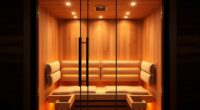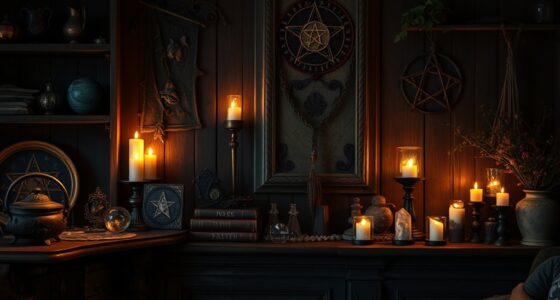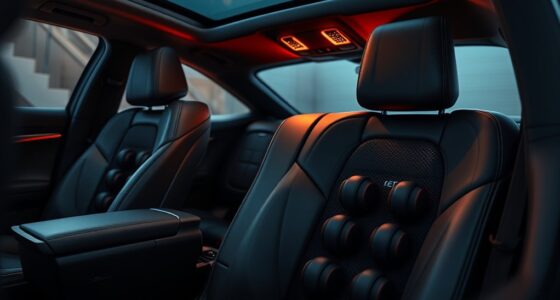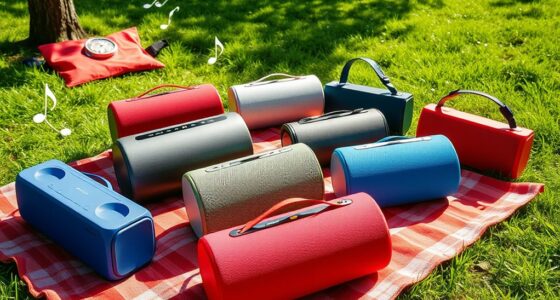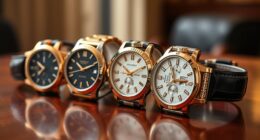If you’re looking to elevate your photography in 2025, I recommend exploring the top premium DSLR lenses like versatile zooms, high-quality telephotos, and stunning portrait primes from brands like Canon, Nikon, and Sigma. These lenses offer exceptional clarity, durability, and creative control, perfect for professionals seeking stunning results. Whether capturing wildlife, portraits, or landscapes, investing in these options pays off. Keep going, and you’ll discover detailed insights on each lens category and what makes them stand out.
Key Takeaways
- Highlights top premium DSLR lenses across categories like zoom, telephoto, portrait, and manual focus for professional-grade photography.
- Emphasizes advanced features such as wide apertures, optical stabilization, weather sealing, and high optical quality.
- Includes options suitable for various budgets, from high-end to affordable professional lenses.
- Details compatibility with Canon, Nikon, and Sony DSLR systems, ensuring future-proofing and versatility.
- Offers insights into build quality, autofocus performance, and specialized features for stunning, high-precision images.
Nikon AF-S DX NIKKOR 55-300mm Lens for Nikon DSLR Cameras
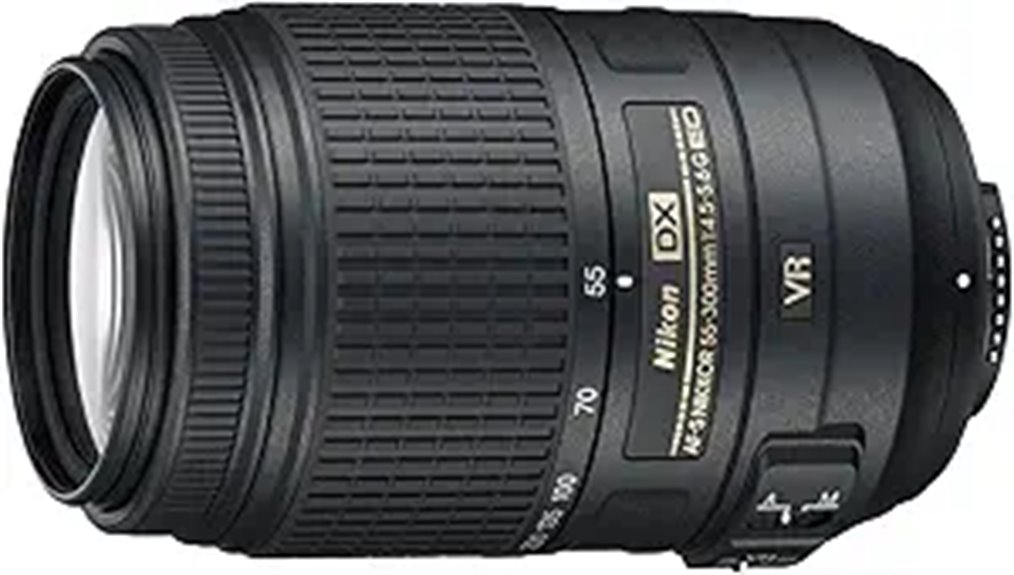
If you’re looking for an affordable yet versatile telephoto lens for your Nikon DSLR, the Nikon AF-S DX NIKKOR 55-300mm is an excellent choice. It offers a 5.5x zoom range from 55mm to 300mm, perfect for outdoor photography, wildlife, and distant subjects. The lens features Nikon’s Vibration Reduction (VR) technology, helping you achieve sharp shots even at full zoom and handheld. With a solid build and lightweight design, it’s easy to handle. The silent wave motor guarantees quick, quiet autofocus, making it user-friendly for hobbyists and enthusiasts alike. Overall, it’s a reliable, high-value option for capturing stunning images in daylight conditions.
Best For: hobbyists and outdoor photographers seeking an affordable, versatile telephoto zoom lens for capturing distant subjects and wildlife in daylight conditions.
Pros:
- Excellent image sharpness across all zoom levels with beautiful Bokeh
- Effective Vibration Reduction (VR) for sharp handheld shots at full zoom
- Solid build quality with lightweight design for comfortable handling
Cons:
- Autofocus may hunt in low contrast or low light, especially at maximum zoom
- Limited performance in low-light conditions due to f/4.5-5.6 aperture
- Slightly open focus when powered off, requiring manual closure of the focus ring
High-Power Telephoto Zoom Lens for Canon Cameras
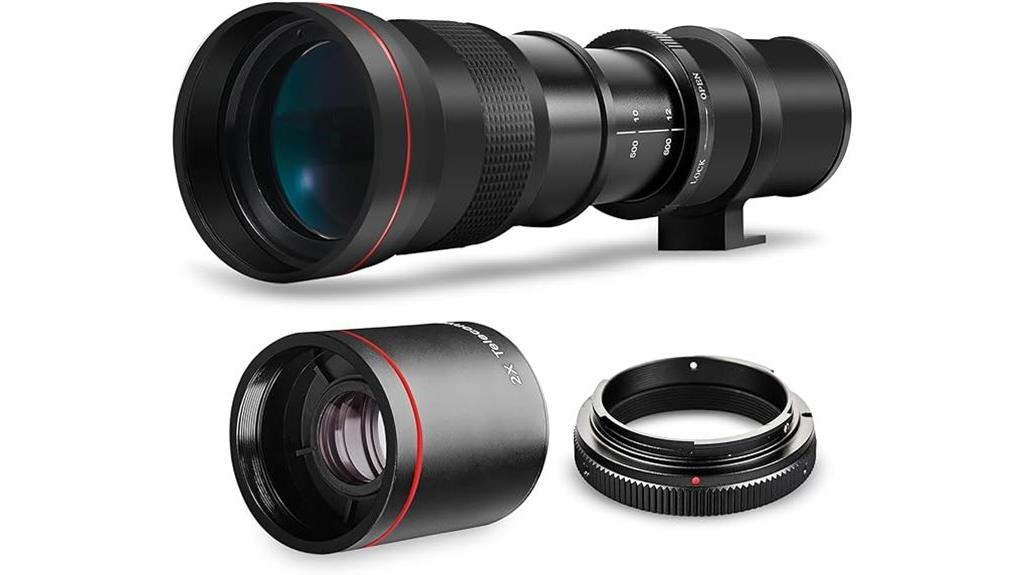
The High-Power Telephoto Zoom Lens for Canon Cameras is ideal for photographers who want to capture distant subjects with remarkable detail, especially wildlife, sports, and celestial scenes. With a focal length of 420-1600mm, plus a 2x teleconverter, it extends reach to 1600mm, making it perfect for distant shots. Its f/8.3 aperture guarantees sharp images at long range, though it requires manual focus and stable support due to the lack of stabilization. Compatible with a wide range of Canon DSLR models, it’s lightweight for its size but demands patience and skill. Many users find it a valuable, budget-friendly tool for moon, wildlife, and landscape photography.
Best For: hobbyist and amateur photographers interested in capturing distant wildlife, sports, and celestial scenes on a budget with manual operation.
Pros:
- Affordable price point (~$150) offers great value for long-range photography.
- Compatible with a wide range of Canon DSLR and mirrorless cameras, ensuring versatility.
- Lightweight design (1.7 pounds) makes it manageable with basic tripods for extended shooting sessions.
Cons:
- No autofocus or image stabilization, requiring manual focus and stable support.
- Fragile tripod mount and mounting clamp can break easily due to cheap plastic components.
- Chromatic aberration and reduced sharpness at full zoom, especially at the edges of the frame.
EF 85mm f1.8 Portrait Lens for Canon DSLR Cameras

Photographers seeking precise manual control and stunning portrait results will find the EF 85mm f1.8 Portrait Lens a compelling choice, especially since it offers exceptional image clarity and dreamy bokeh effects perfect for artistic photography. Designed for Canon DSLR cameras with EF/EF-S mounts, it’s lightweight yet solidly built, with a large focus ring and internal focus mechanism for quick, quiet operation. Although fully manual with no autofocus, its hybrid aspherical elements and multi-coating reduce aberrations and glare, delivering sharp images. While some users note mechanical quirks like loose screws, many praise its optical quality, affordability, and suitability for portrait and artistic work.
Best For: photographers who want precise manual control and stunning portrait results using Canon DSLR cameras, especially those interested in artistic and creative photography.
Pros:
- Delivers exceptional image clarity, sharpness, and beautiful bokeh effects ideal for portraits
- Lightweight, solid metal build with a large focus ring and internal focus mechanism for quick, quiet operation
- Compatible with a broad range of Canon DSLR models, offering versatile usability
Cons:
- Fully manual operation requires switching camera to full manual mode, which may be challenging for some users
- Mechanical quirks such as loose screws and slight lens wobble can affect focus and fit
- No autofocus feature, limiting convenience for fast-paced shooting scenarios
Canon EF 75-300mm f/4-5.6 III Telephoto Zoom Lens for Canon SLR Cameras
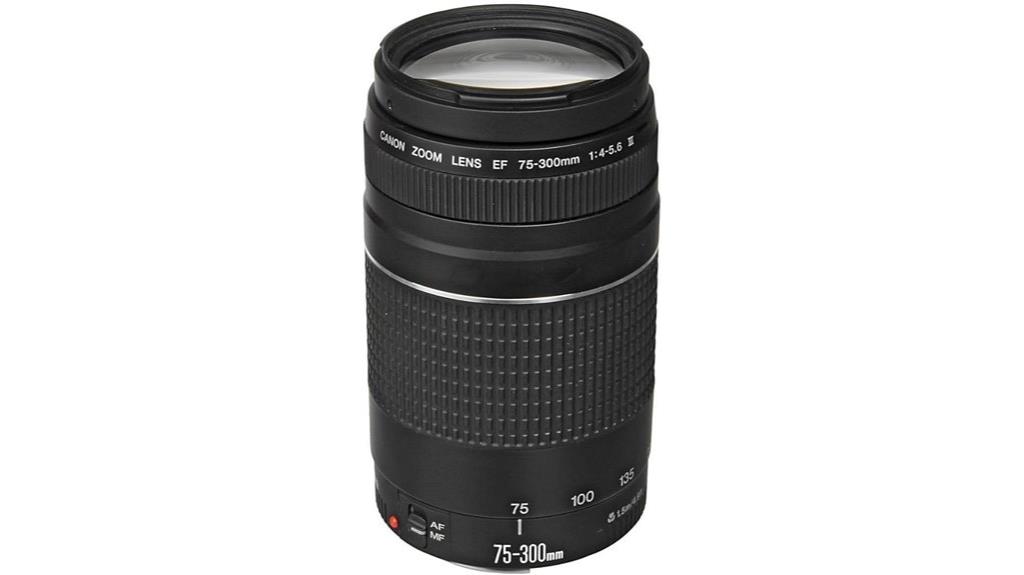
Looking for an affordable telephoto zoom lens that delivers solid performance for casual and hobbyist photography? The Canon EF 75-300mm f/4-5.6 III is compact, lightweight, and easy to handle, weighing just over a pound. It offers a versatile zoom range, ideal for capturing sports, nature, and outdoor scenes from 20 to 400 yards away. With optical image stabilization, smooth zoom, and quiet autofocus, it produces sharp, vibrant images. Its slim design and affordable price make it perfect for beginners or hobbyists seeking a reliable lens without breaking the bank. Plus, it’s a renewed product with a 90-day warranty, ensuring quality and value.
Best For: hobbyists and casual photographers seeking an affordable, lightweight telephoto zoom lens for outdoor, sports, and nature photography.
Pros:
- Compact and lightweight design for easy handling and portability
- Smooth zoom and quiet autofocus suitable for casual shooting
- Optical image stabilization helps produce sharp, vibrant images
Cons:
- Autofocus may be slow for fast-moving subjects
- Limited aperture range (f/4-5.6), less ideal for low-light conditions
- Being a renewed product, it may have a shorter lifespan compared to new lenses
Nikon AF-S FX NIKKOR 50mm f/1.8G Lens for Nikon DSLR Cameras

If you’re seeking a versatile, high-quality prime lens that delivers sharp images across various shooting scenarios, the Nikon AF-S FX NIKKOR 50mm f/1.8G is an excellent choice. Its compact, lightweight design combines a bright f/1.8 aperture with a 50mm focal length, perfect for portraits, street photography, and landscapes. The lens offers edge-to-edge sharpness on FX and DX formats, thanks to advanced aspherical elements. Equipped with Nikon’s silent wave motor for quick, quiet autofocus, it performs well in low-light conditions and produces beautiful background blur. Overall, it’s a reliable, affordable lens that provides professional-quality results for both amateurs and enthusiasts.
Best For: amateur and enthusiast photographers seeking a versatile, sharp, and affordable prime lens for portraits, street, and landscape photography.
Pros:
- Compact, lightweight design makes it easy to carry and handle
- Bright f/1.8 aperture ideal for low-light conditions and beautiful background blur
- Edge-to-edge sharpness across FX and DX formats with quick, quiet autofocus
Cons:
- Slight variability in image sharpness may require stopping down to f/2.8 for optimal results
- Constructed mainly from plastics, which may feel less durable to some users
- Not zoomable, limiting framing flexibility compared to zoom lenses
Sigma 150-600mm 5-6.3 Contemporary DG OS HSM Lens for Nikon
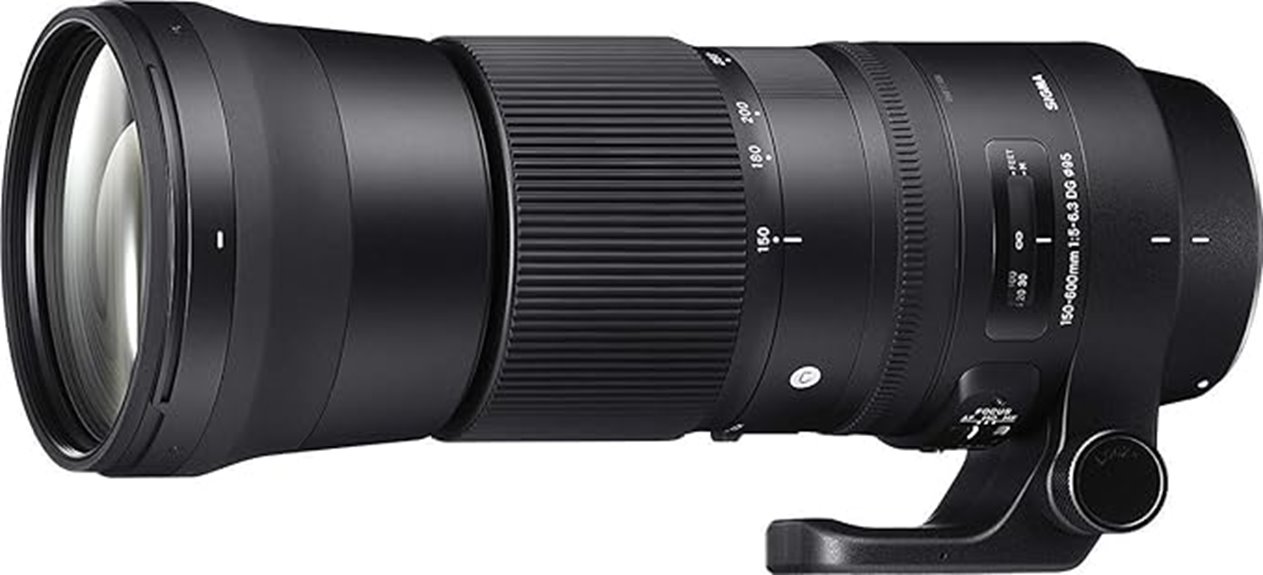
The Sigma 150-600mm f/5-6.3 Contemporary DG OS HSM Lens for Nikon stands out as an excellent choice for wildlife and outdoor photographers seeking versatile, long-reaching zoom capabilities. Its 150-600mm focal length allows for capturing distant subjects with sharp detail, while the lightweight design at around 1930g makes it manageable during long shoots. The lens features optical stabilization, water and oil repellent coatings, and durability with dustproof and splashproof construction. Suitable for full-frame and APS-C cameras, it’s perfect for birding, sports, and nature photography, offering impressive image quality despite its variable aperture. Overall, it’s a reliable, budget-friendly telephoto option.
Best For: wildlife, birding, and outdoor sports photographers seeking a versatile, long-reaching zoom lens with excellent image quality and durability.
Pros:
- Excellent sharpness and detail at various focal lengths, especially between 3-15m
- Lightweight and manageable for outdoor excursions despite its size
- Effective optical stabilization that allows handheld shooting at long focal lengths
Cons:
- Variable aperture limits performance in low-light conditions
- Autofocus can be slower or hunt more at focal lengths above 400mm
- Slight front/back focus issues at 600mm in some user reports
Lightdow EF 240mm F5.6 Reflex Lens for Canon and High-End DSLR Cameras
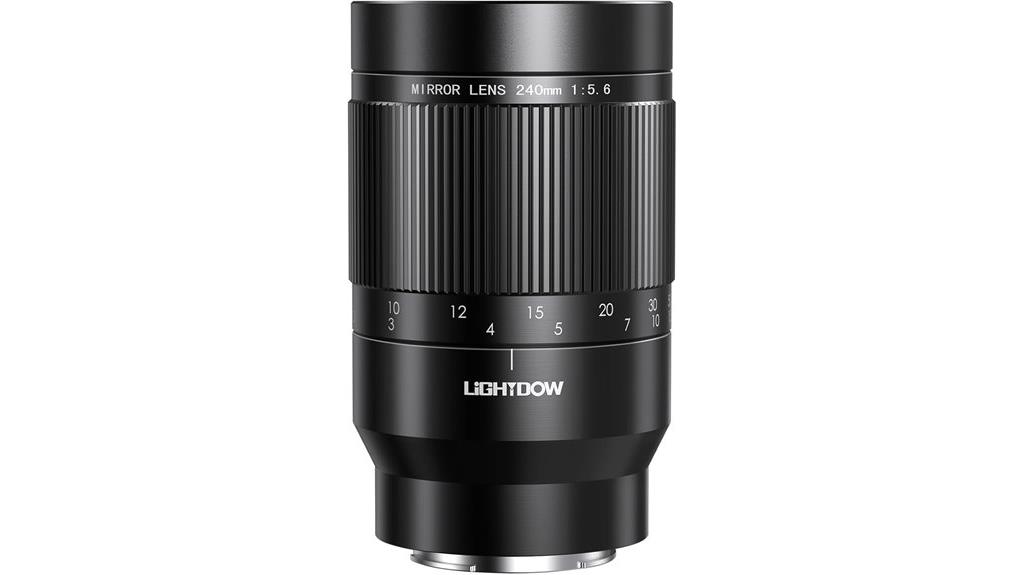
For photographers willing to embrace manual focus and artistic effects, the Lightdow EF 240mm F5.6 Reflex Lens stands out as a unique choice. It’s compatible with many Canon DSLR models, from Rebels to high-end bodies, and its compact, lightweight design makes it perfect for outdoor and travel photography. The lens creates dreamy, donut-shaped bokeh and sharp images thanks to its low-dispersion glass and precise 6-lens arrangement. While manual focusing can be challenging, it rewards patience with distinctive visuals. Ideal for moonshots, wildlife, and artistic landscapes, it offers a creative alternative to standard lenses, especially for enthusiasts enthusiastic to experiment.
Best For: photographers who enjoy manual focus, artistic effects, and are interested in creative, long-range photography such as moonshots, wildlife, and landscapes.
Pros:
- Compact, lightweight design ideal for outdoor and travel use
- Creates distinctive donut-shaped bokeh with artistic appeal
- Compatible with a wide range of Canon DSLR models and offers sharp images with low-dispersion glass
Cons:
- Manual focusing can be challenging, especially for beginners
- Fixed aperture limits control over depth of field
- Less sharp at edges and for fast-moving subjects compared to professional autofocus lenses
High-Power 500mm/1000mm Telephoto Lens for Canon EOS Cameras
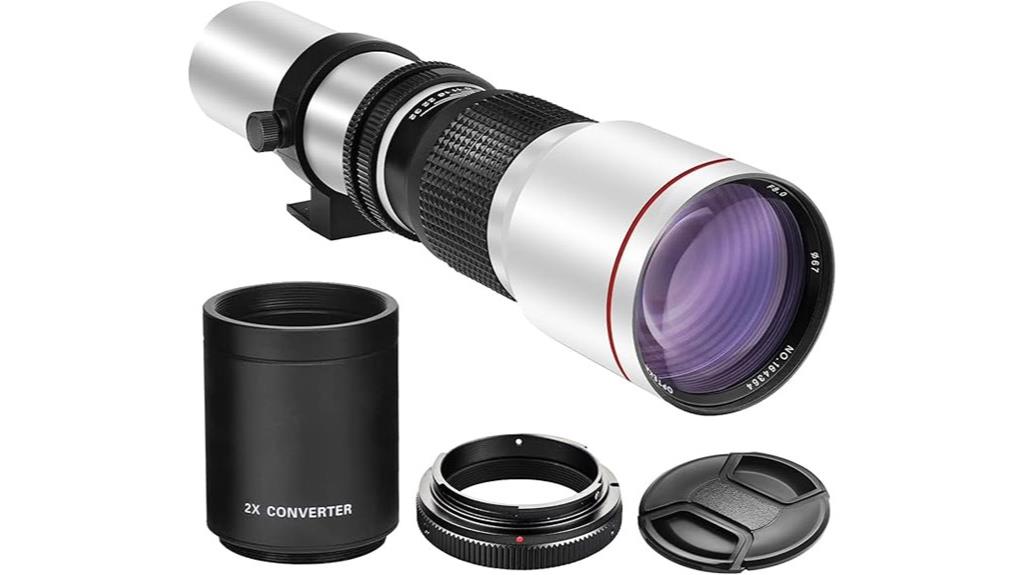
Designed specifically for serious wildlife and landscape photographers, the High-Power 500mm/1000mm Telephoto Lens for Canon EOS cameras delivers exceptional clarity and reach. With its 500mm or 1000mm focal lengths and f/8 aperture, it produces sharp, detailed images even at great distances. The high-quality optical glass with multi-coatings guarantees minimal distortion and vibrant colors. Manual focus and aperture controls give you creative flexibility. The lens doubles to 1000mm with a 2X teleconverter, perfect for capturing distant subjects like wildlife or celestial scenes. Compatible with a wide range of Canon DSLR models, it offers professional-level performance in a versatile package.
Best For: Wildlife and landscape photographers seeking high magnification and sharp detail for distant subjects using Canon EOS cameras.
Pros:
- Offers versatile 500mm and 1000mm focal lengths with a 2X teleconverter for enhanced reach
- High-quality multi-coated optical glass ensures minimal distortion and vibrant images
- Manual focus and aperture controls provide creative flexibility and precise adjustments
Cons:
- Relatively heavy at 2.7 pounds, which may cause fatigue during extended shooting sessions
- Fixed f/8 aperture limits performance in low-light conditions
- Manual focus may be challenging for fast-moving subjects or beginners
High-Power 420-1600mm f/8.3 Telephoto Zoom Lens for Sony DSLR Cameras

If you’re looking to capture distant subjects with exceptional detail, the High-Power 420-1600mm f/8.3 Telephoto Zoom Lens for Sony DSLR Cameras delivers impressive zoom capabilities, especially with its 2X teleconverter that doubles the focal length to 1600mm. Designed for Sony Alpha A-mount cameras, it’s perfect for wildlife, sports, landscapes, and celestial photography. The lens offers a crisp, detailed image at focal lengths between 420mm and 800mm, with an aperture of f/8.3. Although manual focus and bulkiness require a tripod, its long-range reach makes it a valuable tool for professionals and enthusiasts alike.
Best For: outdoor photographers, wildlife enthusiasts, and sports shooters seeking long-distance, high-zoom images with manual focus capabilities on Sony A-mount DSLR cameras.
Pros:
- Provides extensive zoom range up to 1600mm with the 2X teleconverter, ideal for distant subjects
- Compatible with a wide range of Sony Alpha A-mount DSLR cameras for seamless integration
- Offers crisp, detailed images at focal lengths between 420mm and 800mm, suitable for professional and hobbyist use
Cons:
- Manual focus can be challenging and may require steady tripod support for sharp images
- Bulky and heavy build necessitates the use of a tripod for stability during shooting
- Constructed with plastic components in the zoom mechanism, which may affect durability and longevity
Meike 85mm F1.8 Full Frame Portrait Lens for Canon EF Mount
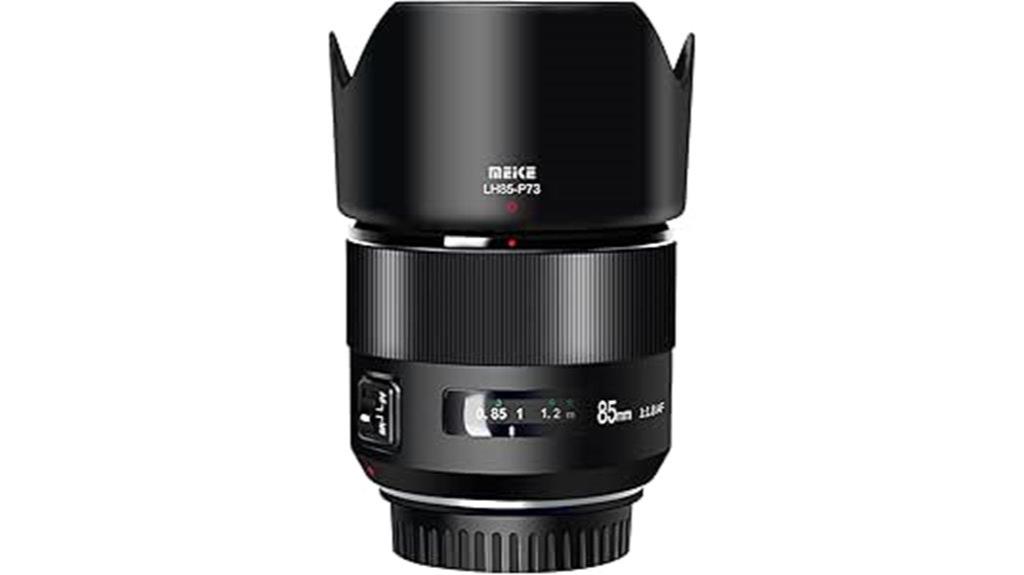
The Meike 85mm F1.8 Full Frame Portrait Lens stands out as an excellent choice for photographers seeking sharp, beautiful portraits with stunning background blur. Its wide f/1.8 aperture creates smooth, round bokeh, perfect for isolating subjects. Compatible with Canon EF mount cameras like the 5D and 6D series, it offers versatile use across different setups. The lens features a durable build, a focus mode switch, and an indicator window for precise focusing. With a lightweight design of 420g and a minimum focus distance of 0.85m, it’s ideal for portrait, architecture, and landscape photography, delivering clarity and creative control.
Best For: photographers seeking a versatile, sharp portrait lens with beautiful background blur for Canon EF mount cameras.
Pros:
- Excellent image sharpness and smooth bokeh with wide f/1.8 aperture
- Durable build quality with convenient focus mode switch and indicator window
- Lightweight and compact design ideal for handheld shooting and extended use
Cons:
- Fixed focal length limits versatility compared to zoom lenses
- No image stabilization features included
- May require additional filters, as it uses a 67mm thread size
420-800mm Telephoto Lens for Canon DSLR Cameras
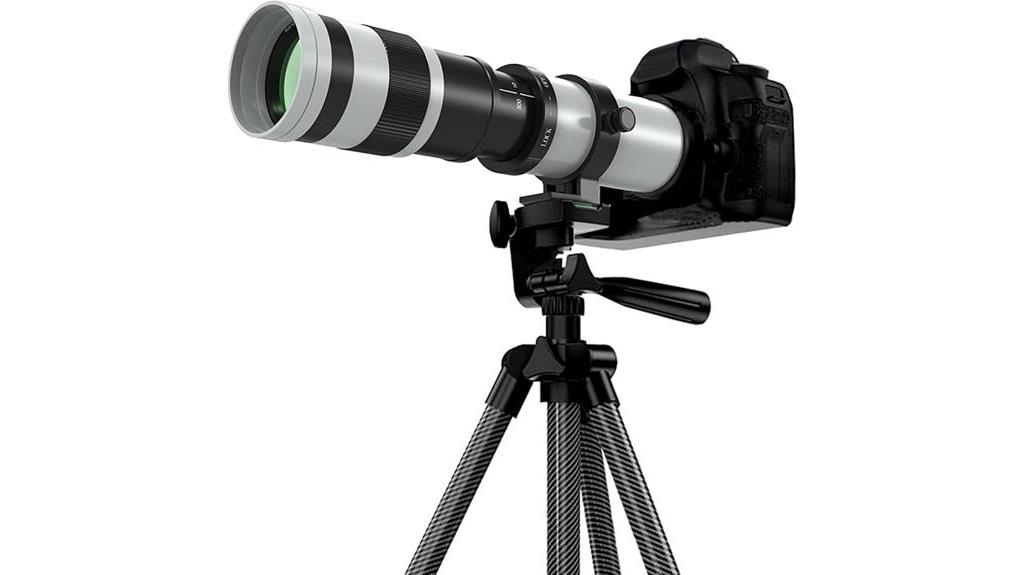
For wildlife and astrophotography enthusiasts using Canon DSLR cameras, the 420-800mm super telephoto manual focus lens offers an affordable way to capture distant subjects with impressive reach. This non-original, manual focus lens features a focal range from 420 to 800mm and an aperture of F/8.3-16, suitable for long-distance shots. Built with durable materials, it’s compatible with Canon EF/EF-S mount cameras, though it lacks autofocus and electronic contacts. Perfect for stable tripod use, it requires manual focus and exposure adjustments. While some users report softness or chromatic aberration, many appreciate its value for hobbyist wildlife and astrophotography, making it an intriguing budget-friendly option.
Best For: hobbyists and wildlife or astrophotography enthusiasts using Canon DSLR cameras seeking an affordable, high-zoom manual telephoto lens for distant subjects.
Pros:
- Offers an extensive focal length range of 420-800mm at an affordable price.
- Durable construction suitable for outdoor and long-term use.
- Lightweight and easy to attach, making it convenient for hobbyist shooting with tripods.
Cons:
- Manual focus may be challenging for quick or action shots.
- Possible image softness, chromatic aberration, or focus issues reported by some users.
- Not compatible with Canon mirrorless or other brand cameras, limiting versatility.
Meike 85mm F1.8 Portrait Lens for Nikon F Mount DSLR Cameras
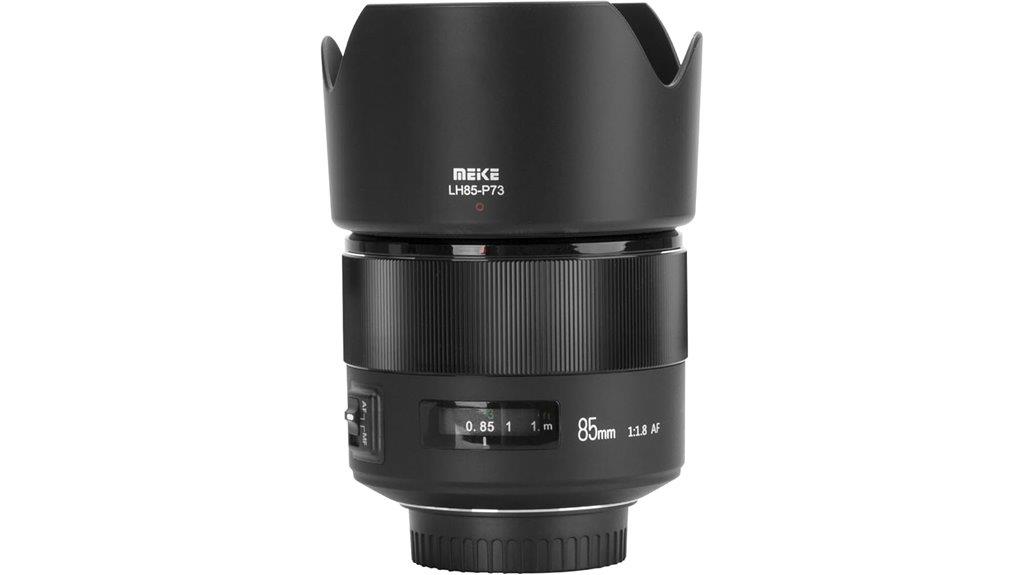
Designed specifically for Nikon F Mount DSLR cameras, the Meike 85mm F1.8 Portrait Lens offers a compelling blend of sharpness, smooth bokeh, and affordability, making it an excellent choice for portrait and landscape photographers seeking professional results on a budget. Its wide F1.8 aperture and nine-blade diaphragm create beautiful background blur, perfect for portraits. While autofocus can be noisy and occasionally indecisive outdoors, manual focus is precise and easy to control. Compatible with both full-frame and APS-C Nikon cameras, it delivers versatile performance. Lightweight and well-built, it includes a lens hood and microfiber bag, offering great value at around $200.
Best For: amateur and hobbyist portrait and landscape photographers seeking an affordable, versatile lens with good image quality for Nikon F Mount DSLR cameras.
Pros:
- Offers sharp images with beautiful bokeh thanks to wide F1.8 aperture and 9-blade diaphragm.
- Lightweight, sleek design with included lens hood and microfiber storage bag, enhancing portability and convenience.
- Compatible with both full-frame and APS-C Nikon cameras, providing versatile shooting options.
Cons:
- Autofocus can be noisy and occasionally indecisive, especially outdoors, which may affect video recording.
- Some users report issues with optical quality, including glare, chromatic aberration, and occasional unsharp images.
- Autofocus response, while generally fast, is not always reliable, leading to potential focus frustrations.
High-Power 500mm/1000mm Telephoto Lens for Nikon Cameras
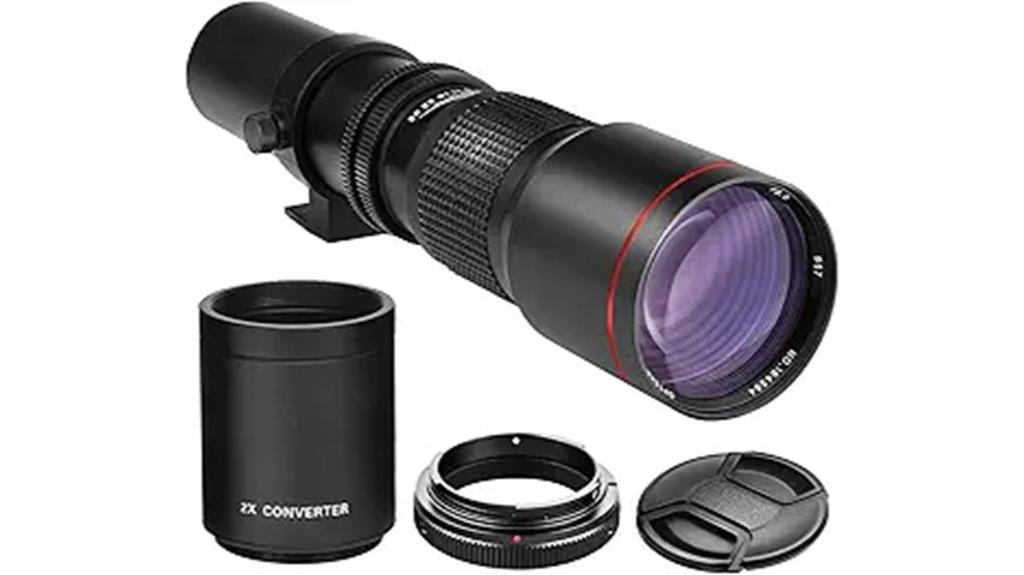
If you’re seeking exceptional reach for wildlife or astrophotography, the High-Power 500mm/1000mm telephoto lens for Nikon cameras offers an impressive solution. Designed for Nikon DSLRs with F-Mount compatibility, it features a sleek black finish, robust build, and manual focus for full creative control. The lens uses high-quality, multi-coated optical glass for sharp images and can double its power with a 2X teleconverter, reaching 1000mm. While some users find manual operation challenging at first, many appreciate its affordability and ability to capture distant subjects. Despite mixed reviews, it remains a popular choice for amateur photographers seeking high magnification without breaking the bank.
Best For: amateur and hobbyist photographers interested in wildlife, landscape, and astrophotography who want an affordable, high-magnification telephoto lens compatible with Nikon DSLR cameras.
Pros:
- High magnification capability up to 1000mm with 2X teleconverter, ideal for distant subjects
- Uses high-quality, multi-coated optical glass for clear, sharp images
- Affordable price point (~$100) makes it accessible for beginners and casual photographers
Cons:
- Manual focus and aperture may require practice and patience to master
- Reports of focus difficulty, wobbling, and occasional product malfunction or missing components
- Compatibility issues with some Nikon camera models leading to potential connectivity problems
High-Power 420-1600mm f/8.3 Telephoto Zoom Lens for Canon EOS R Cameras
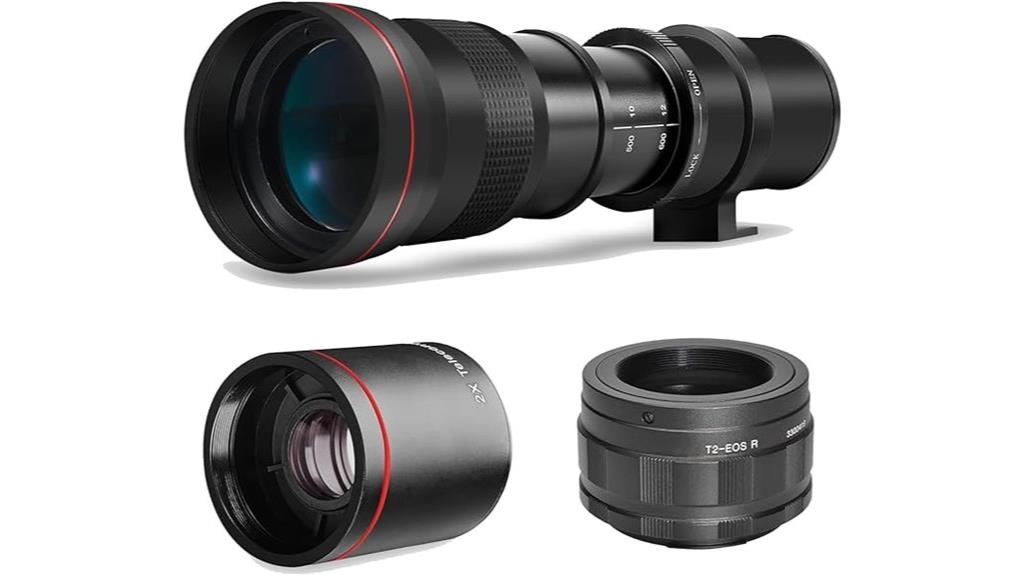
The High-Power 420-1600mm f/8.3 Telephoto Zoom Lens is an excellent choice for experienced photographers who need exceptional reach and manual control. Designed specifically for Canon RF mount mirrorless cameras, it offers a versatile focal length range perfect for wildlife, sports, and distant subjects. With an aperture of f/8.3, it delivers sharp, detailed images across its zoom spectrum. Since it’s manual focus only, you’ll need to adjust focus and aperture yourself, making it ideal for users comfortable with manual operation. Its 62mm filter thread adds flexibility for optical effects and protection, ensuring high-quality results in demanding shooting scenarios.
Best For: Experienced photographers seeking high-power manual telephoto zoom capabilities for wildlife, sports, or distant subjects with precise control on Canon RF mount mirrorless cameras.
Pros:
- Offers an extensive focal length range from 420mm to 1600mm for versatile shooting distances
- Delivers sharp, detailed images with high optical quality across the zoom spectrum
- Designed specifically for RF mount cameras, ensuring secure fit and optimal performance
Cons:
- Manual focus only, requiring user skill and experience
- Not compatible with DSLR or non-RF mount cameras
- Larger and potentially heavier, which may affect portability and handling
EF/EF-S 420-800mm F8.3 Telephoto Zoom Lens for Canon DSLR
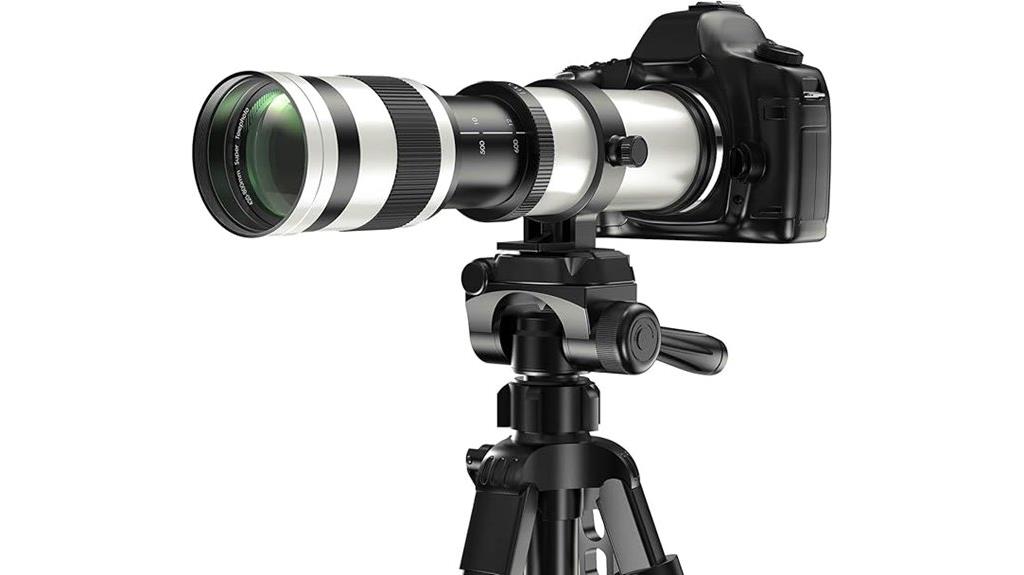
Photographers seeking exceptional telephoto reach will find the EF/EF-S 420-800mm F8.3 lens a perfect fit, especially those comfortable with manual focus. This fully manual lens offers a remarkable 420-800mm zoom range, ideal for wildlife, birds, and distant landscapes. It features a large focus ring, internal focus mechanism, and UMC technology to minimize aberrations and flare, delivering sharp images with beautiful background bokeh. Compatible with Canon EF/EF-S mounts and supporting 62mm filters, it’s designed for professional use. Although it requires full manual operation, it provides excellent stability, creative control, and a rewarding learning experience for serious photographers.
Best For: photographers who are comfortable with manual focus and seek an ultra-telephoto lens for wildlife, birds, and distant landscapes, emphasizing creative control and detailed remote shooting.
Pros:
- Offers an extensive 420-800mm zoom range for distant subject capture
- Fully manual operation provides high stability and creative control
- Features UMC technology to minimize aberrations and flare for sharp, high-quality images
Cons:
- No electronic contacts, requiring manual focus and aperture adjustments only
- Cannot set aperture directly on the camera; displays F00/F– due to manual operation
- Needs full manual mode on the camera, which may be challenging for beginners
Factors to Consider When Choosing Premium Professional DSLR Lenses
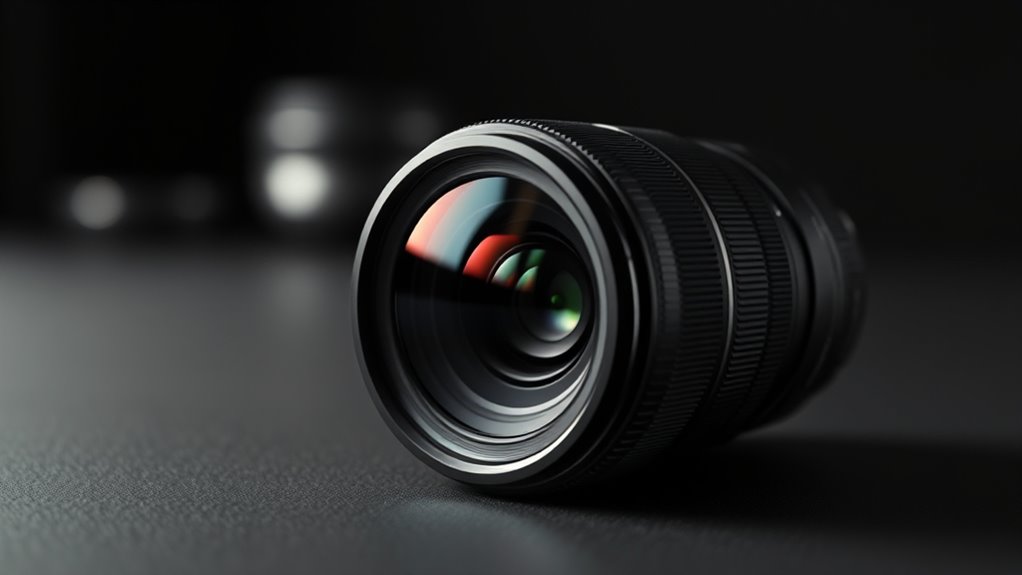
When selecting a premium DSLR lens, I focus on optical quality standards and autofocus capabilities to guarantee sharp, reliable images. I also consider aperture versatility and build durability so the lens performs well in various conditions. Finally, compatibility range is key to making sure the lens fits my camera system and future needs.
Optical Quality Standards
Choosing a premium professional DSLR lens means prioritizing optical quality, which directly impacts the sharpness, clarity, and overall image fidelity. High-end lenses incorporate advanced optical elements like aspherical, low-dispersion, and high-refractive index glass to minimize aberrations and deliver crisp, detailed images from edge to edge. They’re designed to maintain sharp focus even at wide apertures such as f/1.4 or f/2.8, ensuring excellent performance in low-light conditions. Coatings like multi-layer anti-reflective and UMC substantially reduce flare, ghosting, and internal reflections, resulting in high contrast and true-to-life colors. These lenses undergo rigorous testing for resolution, chromatic aberration, and distortion, often meeting strict industry standards. The use of top-tier components ensures durability and consistent optical performance, even in challenging shooting environments.
Autofocus Capabilities
Autofocus capabilities are essential for capturing sharp, well-focused images quickly and reliably, especially in dynamic shooting situations. High-end lenses often feature silent wave or ultrasonic motors, delivering fast, quiet focusing that keeps up with fast-moving subjects like wildlife or sports. Many premium lenses include focus modes such as M/A or instant manual override, allowing seamless switching between autofocus and manual focus without missing a beat. Autofocus performance can be challenged in low contrast scenes, but advanced focusing algorithms and features like focus tracking help maintain accuracy. Manufacturers usually rate their lenses’ autofocus speed and reliability, and premium professional lenses generally outperform standard options in both areas. This ensures I can trust my lens to deliver sharp images precisely when I need them most.
Aperture Versatility
Aperture versatility plays a key role in maximizing a lens’s performance across different shooting scenarios. A wider maximum aperture, like f/1.4 or f/1.8, enhances low-light capabilities and creates beautiful background blur, or bokeh. Variable aperture lenses, such as f/4-5.6, offer flexibility when zooming but can limit consistent exposure settings across focal lengths. In contrast, constant aperture lenses maintain the same maximum aperture throughout the zoom range, providing reliable exposure and greater control during dynamic shoots. Versatility in aperture settings allows me to adapt seamlessly to various lighting conditions and creative needs without switching lenses. This flexibility guarantees I capture sharp, well-exposed images with control over depth of field, making it an essential factor in choosing a premium professional DSLR lens.
Build Durability
When selecting a premium professional DSLR lens, build durability is essential because it guarantees reliable performance in demanding conditions. High-quality materials like metal barrels and reinforced lens elements ensure the lens can withstand frequent use and harsh environments. Weather sealing and dustproof joints protect against moisture, dust, and temperature extremes, extending the lens’s lifespan. Robust focus and zoom mechanisms are designed to operate smoothly even under heavy usage, maintaining alignment and performance. Laser welding and precision assembly techniques keep components securely joined, preventing shifts that could impair image quality. Additionally, shock-resistant features and protective coatings on glass elements help prevent scratches, smudges, and damage from impacts. Prioritizing durability means your lens will perform consistently, no matter where or how tough the shooting conditions become.
Compatibility Range
Choosing the right premium professional DSLR lens requires careful attention to compatibility factors that guarantee seamless performance. First, verify the lens matches your camera’s mount type, like Canon EF or Nikon F, for proper attachment. Check if the lens is designed for full-frame or crop sensor (APS-C) cameras, as this impacts field of view and image quality. Consider whether it offers autofocus, manual focus, or both, based on your shooting style. Confirm compatibility with features like image stabilization and electronic contacts, which affect metering and EXIF data transfer. Additionally, verify if the lens works with accessories such as teleconverters or adapters, extending its versatility across different systems. Paying close attention to these compatibility aspects ensures your investment delivers maximum performance and flexibility.
Price and Value
Evaluating the price and value of premium professional DSLR lenses helps guarantee your investment pays off in the long run. These lenses typically cost between $1,000 and over $3,000, reflecting their advanced optics and build quality. When appraising value, I consider optical performance, durability, and features like image stabilization and weather sealing. Higher-priced lenses tend to deliver sharper images, better contrast, and richer color, which justify the expense for professional results. It’s also important to compare the cost against your specific needs and how long you expect to use the lens. Reading user reviews and choosing reputable brands ensures that the price aligns with quality and long-term satisfaction. Ultimately, the right lens offers excellent performance and durability that make it worth the investment.
Frequently Asked Questions
What Are the Best Lenses for Low-Light Professional Photography?
For low-light professional photography, I swear by fast prime lenses with wide apertures like f/1.4 or f/1.2. The Canon RF 50mm f/1.2L and Nikon 58mm f/1.4 are fantastic choices because they let in plenty of light, helping me capture sharp, well-exposed images even in dim conditions. I always recommend choosing lenses with large maximum apertures for better performance in low-light settings.
How Do Weather Sealing Features Impact Lens Durability?
Weather sealing features greatly boost a lens’s durability by protecting against dust, moisture, and light rain. I’ve found that sealed lenses let me shoot confidently in challenging conditions without worry. They prevent damage from environmental elements, extending the lifespan of my gear. If you’re serious about professional photography, investing in weather-sealed lenses ensures your equipment stays protected, so you can focus on capturing stunning images no matter the weather.
Which Lenses Offer the Fastest Autofocus for Sports Photography?
Think of autofocus like a race car zooming to the finish line; speed matters. I’ve found that lenses like the Canon EF 70-200mm f/2.8L IS III USM and Nikon AF-S NIKKOR 70-200mm f/2.8E FL ED VR deliver lightning-fast focus, essential for capturing fast-paced sports. They use advanced motors to lock onto subjects instantly, helping me freeze those split-second moments with precision and clarity.
What Is the Optimal Lens Choice for Astrophotography?
For astrophotography, I recommend a wide-angle lens with a large maximum aperture, like a 14mm f/2.8 or 24mm f/1.4. These lenses let in plenty of light, capturing stars and night sky details beautifully. I prefer prime lenses because they’re sharper and have fewer distortions. Using a sturdy tripod and manual focus helps, but choosing a lens with a fast aperture is essential for clear, stunning astrophotos.
How Does Lens Weight Influence Handheld Shooting Stability?
When it comes to handheld shooting, lens weight is like carrying a backpack—light ones let you move freely, while heavy ones can weigh you down and cause camera shake. I find that lighter lenses help me stay steady, especially during long shoots, making my photos sharper. If a lens is too heavy, I often use a stabilizer or tripod to keep things steady. So, lighter lenses boost stability and make shooting more enjoyable.
Conclusion
In the world of professional photography, these lenses are your magic wands, transforming every shot into a masterpiece so stunning it’ll stop time itself. Imagine capturing the impossible, revealing details so sharp they cut through the noise, and creating images so breathtaking, they’ll leave viewers breathless. Trust me, with these premier lenses, you’re not just taking photos—you’re crafting timeless art that will dominate the future of photography in 2025 and beyond.

